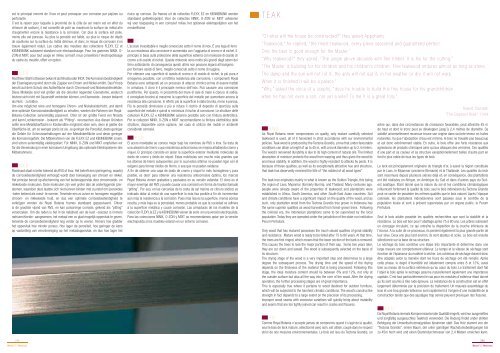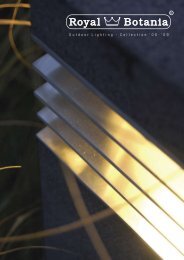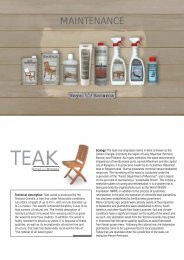Royal Botania Outdoor Furniture Technical Catalogue (PDF - 1
Royal Botania Outdoor Furniture Technical Catalogue (PDF - 1
Royal Botania Outdoor Furniture Technical Catalogue (PDF - 1
Create successful ePaper yourself
Turn your PDF publications into a flip-book with our unique Google optimized e-Paper software.
est le principal ennemi de l’inox et peut provoquer une corrosion par piqûres ou<br />
perforante.<br />
C’est la raison pour laquelle à proximité de la côte (le sel marin est en effet du<br />
chlorure de sodium), il est conseillé de polir au maximum la surface du métal afi n<br />
d’augmenter encore la résistance à la corrosion. Car plus la surface est polie,<br />
moins elle est poreuse. Au plus la porosité est faible, au plus le risque de dépôt<br />
de souillures sur la surface du métal diminue, et donc, le risque de corrosion s’en<br />
trouve également réduit. Les cadres des meubles des collections FLEXY, EZ et<br />
KENNEBUNK subissent standard une electopolissage. Pour les gammes NINIX, O-<br />
ZON et MIXT, pour tout usage en milieu corrosif, nous conseillons l’electropolissage<br />
du cadre du meuble, offert en option.<br />
DEU<br />
Rostfreier Stahl ist besser bekannt als Nirosta oder INOX. Die Korrosionsbeständigkeit<br />
der Eisenlegierung wird durch die Zugabe von Chrom und Nickel erhöht. Das Prinzip<br />
beruht auf dem Schutz des Außenfl äche durch Chromoxid-und Nickeloxidmoleküle.<br />
Diese Moleküle sind viel größer als die darunter liegenden Eisenatome, wodurch<br />
letztere sich nicht mit Sauerstoff verbinden können, um Eisenoxide - besser bekannt<br />
als Rost - zu bilden.<br />
Um eine möglichst reine und homogene Chrom- und Nickeloxidschicht, und damit<br />
eine optimale Korrosionsbeständigkeit zu erhalten, werden die Rahmen der <strong>Royal</strong>-<br />
<strong>Botania</strong>-Collection serienmäßig passiviert. Chlor ist der größte Feind von Nirosta<br />
und kann Lochkorrosion - bekannt als “Pitting“- verursachen. Aus diesen Gründen<br />
sollte eine Metalloberfl äche in Küstennähe möglichst eben sein, denn je glatter die<br />
Oberfl äche ist, um so weniger porös ist sie. Je geringer die Porosität, desto geringer<br />
die Gefahr für Schmutzanhaftungen auf der Metalloberfl äche und desto geringer<br />
die Korrosionsgefahr. Die Möbelrahmen von die FLEXY, EZ und KENNEBUNK Linien,<br />
sind schon serienmäßig elektropoliert. Für NINIX, O-ZON und MIXT empfehlen wir<br />
für die Verwendung in einer korrosiven Umgebung das optionale Elektropolieren des<br />
Möbelrahmens.<br />
NED<br />
Roestvast staal is beter bekend als RVS of Inox. Het betreft een ijzerlegering, waarbij<br />
de corrosiebestendigheid verhoogd wordt door toevoeging van chroom en nikkel.<br />
Het principe berust op afscherming van het buitenoppervlak door chroomoxide- en<br />
nikkeloxide moleculen. Deze moleculen zijn veel groter dan de onderliggende ijzeratomen,<br />
waardoor deze laatste zich niet kunnen binden met zuurstof om ijzeroxides<br />
-beter bekend als roest- te vormen. Teneinde een zo zuiver en homogeen mogelijke<br />
chroom- en nikkeloxide huid, en dus een optimale corrosiebestendigheid te<br />
verkrijgen worden de <strong>Royal</strong> <strong>Botania</strong> frames standaard gepassiveerd. Chloor<br />
is de grootste vijand van RVS, en kan putvormige corrosie, gekend als “pitting”<br />
veroorzaken. Om die reden is het in de nabijheid van de kust –zeezout is immers<br />
natriumchloride- aangewezen, het metaal een zo glad mogelijk oppervlak te geven,<br />
teneinde de corrosiebestendigheid nog verder op te voeren. Immers hoe gladder<br />
het oppervlak hoe minder poreus. Hoe lager de porositeit, hoe geringer de kans<br />
op vastzetting van verontreiniging op het metaaloppervlak, en dus hoe lager het<br />
risico op corrosie. De frames uit de collecties FLEXY, EZ en KENNEBUNK worden<br />
standaard geëlektropolijst. Voor de collecties NINIX, O-ZON en MIXT adviseren<br />
wij voor toepassing in een corrosief milieu het optioneel elektropolijsten van het<br />
meubelframe.<br />
IT<br />
L’acciaio inossidabile è meglio conosciuto sotto il nome di inox. È una lega di ferro<br />
la cui resistenza alla corrosione è aumentata con l’aggiunta di cromo e di nichel. Il<br />
principio si basa sulla protezione della superfi cie esterna con molecole di ossido di<br />
cromo e di ossido di nichel. Queste molecole sono molto più grandi degli atomi del<br />
ferro sottostante; di conseguenza questi ultimi non possono legarsi all’ossigeno<br />
per formare ossidi di ferro, meglio conosciuti sotto il nome di ruggine.<br />
Per ottenere una superfi cie di ossido di cromo e di ossido di nichel, la più pura e<br />
omogenea possibile, con un’ottima resistenza alla corrosione, i componenti <strong>Royal</strong><br />
<strong>Botania</strong> sono sottoposti ad un processo di attacco chimico prima di essere trattati<br />
in armatura. Il cloro è il principale nemico dell’inox. Può causare una corrosione<br />
puntiforme. Per questo, in prossimità del mare (il sale di mare è cloruro di sodio),<br />
è consigliato brunire al massimo la superfi cie del metallo per aumentare ancora la<br />
resistenza alla corrosione. In effetti, più la superfi cie è stata brunita, meno è porosa.<br />
Più la porosità diminuisce e più si riduce il rischio di deposito di sporcizia sulla<br />
superfi cie del metallo e quindi si minimizza il rischio di corrosione. Le strutture delle<br />
collezioni FLEXY, EZ e KENNEBUNK saranno prodotte solo con fi nitura elettrolitica.<br />
Per le collezioni NINIX, O-ZON e MIXT raccomandiamo la fi nitura elettrolitica delle<br />
strutture, disponibile come opzione, nel caso di utilizzo dei mobili in ambienti<br />
considerati corrosivi.<br />
ESP<br />
El acero inoxidable se conoce mejor bajo los nombres de RVS o Inox. Se trata de<br />
una aleación de hierro cuya resistencia anticorrosiva se mejora añadiendo cromo y<br />
níquel. El principio consiste en aislar la superfi cie exterior mediante moléculas de<br />
óxido de cromo y óxido de níquel. Estas moléculas son mucho más grandes que<br />
los átomos de hierro subyacentes, por lo cual estos últimos no pueden ligar con el<br />
oxígeno para formar óxidos de hierro, o sea que no pueden oxidarse.<br />
A fi n de obtener una capa de óxido de cromo y níquel lo más homogénea y pura<br />
posible, es decir para obtener una resistencia anticorrosiva óptima, los marcos<br />
<strong>Royal</strong> <strong>Botania</strong> vienen grabados y pasivados en su versión estándar. El cloro es el<br />
mayor enemigo del RVS y puede causar una corrosión en forma de hoyitos llamado<br />
“pitting”. Por eso, en las cercanías de la costa (la sal marina es cloruro sódico) es<br />
indicado dotar al metal de una superfi cie lo más lisa posible a fi n de incrementar<br />
aún más la resistencia a la corrosión. Pues más lisa es la superfi cie, menos porosa<br />
resulta, y más baja es la porosidad, menos probable es que la suciedad se adhiera<br />
a la superfi cie metálica y cause corrosión. Las armaduras de los muebles de la<br />
colección FLEXY, la EZ y la KENNEBUNK vienen de serie en una versión electropulida.<br />
Para las colecciones NINIX, O-ZON y MIXT os recomendamos optar por la versión<br />
electropulida si los muebles estarán en un entorno corrosivo.<br />
244 245<br />
TEAK<br />
“Of what will the house be constructed?” they asked Appuhamy.<br />
“Teakwood,” he replied, “the finest teakwood, every piece seasoned and guaranteed perfect.<br />
Only the best is good enough for the Master.”<br />
“Why teakwood?” they asked. “The jungle above abounds with fine timber. It is his for the cutting.”<br />
“The Master is building for his children and his children’s children. Fine teakwood endures almost as long as stone.<br />
The damp and the sun will not rot it; the ants will not eat it; in hot weather or dry it will not warp.<br />
When it is finished it will be a palace.”<br />
”Why,” asked the voice of a sceptic, “does he trouble to build this fine house for his grandchildren<br />
when he has not even a son, nor yet a wife? To me it is a great folly.”<br />
ENG<br />
As <strong>Royal</strong> <strong>Botania</strong> never compromises on quality, only mature carefully selected<br />
teakwood is used, all of it harvested in strict accordance with our environmental<br />
policies. Teak wood is produced by the Tectona Grandis, a tree that under favourable<br />
conditions can attain a height of up to 45 m, with a trunk diameter up to 2.4 meters.<br />
The wood’s renowned durability is due to its high content of natural oils. The limited<br />
absorption of moisture protects the wood from warping and thus gives the wood its<br />
enormous stability. In addition, the wood is highly resistant to attacks by pests. It is<br />
because of these qualities, as well as its exceptionally attractive hue and structure,<br />
that teak has deservedly received the title of “the noblest of all wood types”<br />
The teak tree originates mainly in what is known as the Golden Triangle, this being<br />
the region of Laos, Myanmar (formerly Burma), and Thailand. Many centuries ago,<br />
people were already aware of the properties of teakwood, and plantations were<br />
established in Africa, South America, and other South-East Asian countries. Soil<br />
and climate conditions have a signifi cant impact on the quality of the wood, and as<br />
such, only plantation wood from the Tectona Grandis tree grown in Indonesia has<br />
the same superior qualities as wood harvested from forest-grown trees. Following<br />
the colonial era, the Indonesian plantations came to be supervised by the local<br />
population. Today they are operated under the jurisdiction of the state-run institution<br />
Perum Perhutani.<br />
Only wood that has matured possesses the much valued qualities of great stability<br />
and resistance. Mature wood is ready to be felled after 75 to 80 years. At that time,<br />
the trees are fi rst ringed, which means that the lower section of the bark is removed.<br />
This causes the trees to lose the major portion of their sap. Some two years later,<br />
they are cut down and sawed. The wood is subsequently selected on the basis of<br />
its structure.<br />
The drying stage of the wood is a very important step and determines to a large<br />
degree the subsequent process. The drying time and the speed of the drying<br />
depends on the thickness of the material that is being processed. Following this<br />
stage, the ideal moisture content should lie between 8% and 12%, not only at<br />
the outside surface but also all the way into the core of the wood. After the drying<br />
operation, the further processing stages are of great importance.<br />
This is especially true where it pertains to wood destined for outdoor furniture,<br />
which will be subjected to the harshest climatic conditions. The wood’s constructive<br />
strength in fact depends to a large extent on the precision of its processing.<br />
Improper wood seams with excessive variations will quickly bring about instability<br />
and seams that are too tightly joined can result in cracks and fi ssures.<br />
FR<br />
Comme <strong>Royal</strong> <strong>Botania</strong> n’accepte jamais de compromis quand il s’agit de la qualité,<br />
seul le bois de teck mature, sélectionné avec soin, est utilisé, coupé dans le respect<br />
strict de nos mesures environnementales. Le bois est issu du Tectona Grandis, un<br />
Robert Standish<br />
“The Elephant Walk” 1949<br />
arbre qui, dans des circonstances de croissance favorables, peut atteindre 45 m<br />
de haut et dont le tronc peut se développer jusqu’à 2,4 mètres de diamètre. Sa<br />
solidité universellement reconnue trouve son origine dans sa forte teneur en huiles<br />
naturelles. Vu que l’absorption d’eau est minime, le bois ne travaille pas beaucoup<br />
et est donc extrêmement stable. En outre, le bois offre une forte résistance aux<br />
agressions de produits chimiques ainsi qu’aux attaques des vermines. Ces qualités<br />
d’une part et sa couleur et sa structure exceptionnellement belles d’autre part en<br />
font le plus noble de tous les types de bois.<br />
Le teck est principalement originaire du triangle d’or, à savoir la région constituée<br />
par le Laos, le Myanmar (ancienne Birmanie) et la Thaïlande. Les qualités du teck<br />
sont reconnues depuis plusieurs siècles déjà et, en conséquence, des plantations<br />
ont été réalisées en Afrique, en Amérique du Sud et dans d’autres pays du Sudest<br />
asiatique. Etant donné que la nature du sol et les conditions climatologiques<br />
infl uencent fortement la qualité du bois, seul le bois indonésien du Tectona Grandis<br />
peut se vanter de posséder les mêmes qualités que le bois naturel. Après l’époque<br />
coloniale, les plantations indonésiennes sont passées sous le contrôle de la<br />
population locale et sont à présent supervisées par un organe public, le Perum<br />
Perhutani.<br />
Seul le bois adulte possède les qualités recherchées que sont la stabilité et la<br />
résistance. Le bois est bon pour l’abattage après 75 à 80 ans. Les arbres subissent<br />
un écorçage circulaire, ce qui entraîne la disparition de la couche inférieure de<br />
l’écorce. A la suite de ce processus, ils perdent également la plus grande partie de<br />
leur sève. Deux ans plus tard environ, ils sont abattus et sciés. Le bois est ensuite<br />
sélectionné sur la base de sa structure.<br />
Le séchage du bois constitue une étape très importante et détermine dans une<br />
large mesure son comportement ultérieur. Le temps et la vitesse de séchage sont<br />
fonction de l’épaisseur du matériel à sécher. Les schémas de séchage doivent donc<br />
être adaptés selon la manière dont les fours de séchage ont été remplis. Après<br />
cette phase, le degré d’humidité est idéalement compris entre 8 et 12%, aussi<br />
bien au niveau de la surface extérieure qu’au cœur du bois. Le traitement dont fait<br />
l’objet le bois après le séchage assume naturellement également une importance<br />
capitale. C’est tout particulièrement le cas pour les meubles d’extérieur étant donné<br />
qu’ils sont soumis à très rude épreuve. La résistance de la construction est en effet<br />
largement déterminée par la précision du traitement. Un mauvais assemblage du<br />
bois et une trop grande tolérance sont rapidement à l’origine d’une instabilité de la<br />
construction tandis que des ajustages trop serrés peuvent provoquer des fi ssures.<br />
DEU<br />
Da <strong>Royal</strong> <strong>Botania</strong> niemals Kompromisse bei der Qualität eingeht, wird nur ausgereiftes<br />
und sorgfältig ausgesuchtes Teakholz verwendet. Die Rodung fi ndet under strikter<br />
Befolgung der Umweltschutzma(griekse b)nahmen statt. Das Holz stammt von der<br />
“Tectona Grandis“, einem Baum, der unter günstigen Wachstumsbedingungen bis<br />
zu 45m hoch wird und einen Stammdurchmesser von 2,4 Metern erreichen kann.





